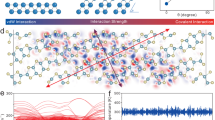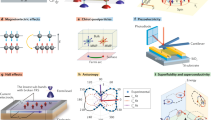Abstract
Research into 2D materials has been growing with impressive speed since the discovery of graphene. Such layered materials with ultrathin morphologies and extreme aspect ratios currently display a vast range of properties; however, until recently a conspicuously missing property of 2D materials was global chirality. The situation has changed over the past few years with the implementation of several distinct types of ultrathin chiral 2D crystals. Here we offer a forward-looking perspective on this field to comprehend the fundamentals of global chirality in two dimensions and develop new directions. We specifically discuss the experimental achievements of the emerging chiral 2D materials with a focus on their design strategy, synthesis, structural characterization, fundamental physical properties and possible applications. We will highlight how the molecular-scale local chirality could be significantly transmitted and amplified throughout ultrathin single-crystalline 2D structures, resulting in distinctive global chirality that brings more sophisticated functions.

This is a preview of subscription content, access via your institution
Access options
Access Nature and 54 other Nature Portfolio journals
Get Nature+, our best-value online-access subscription
$29.99 / 30 days
cancel any time
Subscribe to this journal
Receive 12 print issues and online access
$259.00 per year
only $21.58 per issue
Buy this article
- Purchase on SpringerLink
- Instant access to full article PDF
Prices may be subject to local taxes which are calculated during checkout




Similar content being viewed by others
References
Novoselov, K. S. et al. Electric field effect in atomically thin carbon films. Science 306, 666–669 (2004).
Du, Z. et al. Conversion of non-van der Waals solids to 2D transition-metal chalcogenides. Nature 577, 492–496 (2020).
Varoon, K. et al. Dispersible exfoliated zeolite nanosheets and their application as a selective membrane. Science 334, 72–75 (2011).
Ma, K. Y. et al. Epitaxial single-crystal hexagonal boron nitride multilayers on Ni (111). Nature 606, 88–93 (2022).
Wu, Z. et al. Large-scale growth of few-layer two-dimensional black phosphorus. Nat. Mater. 20, 1203–1209 (2021).
Li, Y. et al. A general Lewis acidic etching route for preparing MXenes with enhanced electrochemical performance in non-aqueous electrolyte. Nat. Mater. 19, 894–899 (2020).
Dou, L. et al. Atomically thin two-dimensional organic-inorganic hybrid perovskites. Science 349, 1518–1521 (2015).
Datta, S. J. et al. Rational design of mixed-matrix metal-organic framework membranes for molecular separations. Science 376, 1080–1087 (2022).
Liu, K. et al. On-water surface synthesis of crystalline, few-layer two-dimensional polymers assisted by surfactant monolayers. Nat. Chem. 11, 994–1000 (2019).
Chakraborty, G., Park, I.-H., Medishetty, R. & Vittal, J. J. Two-dimensional metal–organic framework materials: synthesis, structures, properties and applications. Chem. Rev. 121, 3751–3891 (2021).
Zhang, H. Ultrathin two-dimensional nanomaterials. ACS Nano 9, 9451–9469 (2015).
Tan, C. et al. Recent advances in ultrathin two-dimensional nanomaterials. Chem. Rev. 117, 6225–6331 (2017).
Schaibley, J. R. et al. Valleytronics in 2D materials. Nat. Rev. Mater. 1, 16055 (2016).
Chen, Y. et al. Two-dimensional metal nanomaterials: synthesis, properties, and applications. Chem. Rev. 118, 6409–6455 (2018).
Pham, P. V. et al. 2D heterostructures for ubiquitous electronics and optoelectronics: Principles, opportunities, and challenges. Chem. Rev. 122, 6514–6613 (2022).
Hu, C.-X., Shin, Y., Read, O. & Casiraghi, C. Dispersant-assisted liquid-phase exfoliation of 2D materials beyond graphene. Nanoscale 13, 460–484 (2021).
Mendes, R. G. et al. Electron-driven in situ transmission electron microscopy of 2D transition metal dichalcogenides and their 2D heterostructures. ACS Nano 13, 978–995 (2019).
Backes, C. et al. Guidelines for exfoliation, characterization and processing of layered materials produced by liquid exfoliation. Chem. Mater. 29, 243–255 (2017).
Shen, B., Kim, Y. & Lee, M. Supramolecular chiral 2D materials and emerging functions. Adv. Mater. 32, 1905669 (2020).
Gong, W., Chen, Z., Dong, J., Liu, Y. & Cui, Y. Chiral metal–organic frameworks. Chem. Rev. 122, 9078–9144 (2022).
Dong, J. et al. Free-standing homochiral 2D monolayers by exfoliation of molecular crystals. Nature 602, 606–611 (2022).
Livnah, O., Bayer, E. A., Wilchek, M. & Sussman, J. L. Three-dimensional structures of avidin and the avidin-biotin complex. Proc. Natl Acad. Sci. USA 90, 5076–5080 (1993).
Guo, J. et al. Ultrathin chiral metal–organic-framework nanosheets for efficient enantioselective separation. Angew. Chem. Int. Ed. 57, 6873–6877 (2018).
Tan, C. et al. Boosting enantioselectivity of chiral organocatalysts with ultrathin two-dimensional metal–organic framework nanosheets. J. Am. Chem. Soc. 141, 17685–17695 (2019).
Makam, P. et al. Single amino acid bionanozyme for environmental remediation. Nat. Commun. 13, 1505 (2022).
Liu, L., Zhang, D., Zhu, Y. & Han, Y. Bulk and local structures of metal–organic frameworks unravelled by high-resolution electron microscopy. Commun. Chem. 3, 99 (2020).
Zhang, D. et al. Atomic-resolution transmission electron microscopy of electron beam–sensitive crystalline materials. Science 359, 675–679 (2018).
Liu, Y. et al. Single-crystalline ultrathin 2D porous nanosheets of chiral metal–organic frameworks. J. Am. Chem. Soc. 143, 3509–3518 (2021).
Guo, Y., Nuermaimaiti, A., Kjeldsen, N. D., Gothelf, K. V. & Linderoth, T. R. Two-dimensional coordination networks from cyclic dipeptides. J. Am. Chem. Soc. 142, 19814–19818 (2020).
Geng, K. et al. Covalent organic frameworks: design, synthesis, and functions. Chem. Rev. 120, 8814–8933 (2020).
Han, X. et al. Chiral covalent organic frameworks: design, synthesis and property. Chem. Soc. Rev. 49, 6248–6272 (2020).
Dong, J., Han, X., Liu, Y., Li, H. & Cui, Y. Metal–covalent organic frameworks (MCOFs): a bridge between metal–organic frameworks and covalent organic frameworks. Angew. Chem. Int. Ed. 59, 13722–13733 (2020).
Wu, X. et al. Chiral BINOL-based covalent organic frameworks for enantioselective sensing. J. Am. Chem. Soc. 141, 7081–7089 (2019).
Dong, J. et al. Restriction of molecular rotors in ultrathin two-dimensional covalent organic framework nanosheets for sensing signal amplification. Chem. Mater. 31, 146–160 (2019).
Han, X. et al. Chiral induction in covalent organic frameworks. Nat. Commun. 9, 1294 (2018).
Chen, H., Gu, Z.-G. & Zhang, J. Chiral-induced ultrathin covalent organic frameworks nanosheets with tunable circularly polarized luminescence. J. Am. Chem. Soc. 144, 7245–7252 (2022).
Zhan, G. et al. Observing polymerization in 2D dynamic covalent polymers. Nature 603, 835–840 (2022).
Xu, H., Gao, J. & Jiang, D. Stable, crystalline, porous, covalent organic frameworks as a platform for chiral organocatalysts. Nat. Chem. 7, 905–912 (2015).
Zhang, S., Zhou, J. & Li, H. Chiral covalent organic framework packed nanochannel membrane for enantioseparation. Angew. Chem. Int. Ed. 61, e202204012 (2022).
Sun, B. et al. Homochiral porous nanosheets for enantiomer sieving. Nat. Mater. 17, 599–604 (2018).
Chen, T., Yang, W.-H., Wang, D. & Wan, L.-J. Globally homochiral assembly of two-dimensional molecular networks triggered by co-absorbers. Nat. Commun. 4, 1389 (2013).
Fang, Y. et al. Dynamic control over supramolecular handedness by selecting chiral induction pathways at the solution–solid interface. Nat. Chem. 8, 711–717 (2016).
Sun, B. et al. Asymmetric transformation driven by confinement and self-release in single-layered porous nanosheets. Angew. Chem. Int. Ed. 59, 22690–22696 (2020).
Insua, I. & Montenegro, J. 1D to 2D self assembly of cyclic peptides. J. Am. Chem. Soc. 142, 300–307 (2020).
Long, G. et al. Chiral-perovskite optoelectronics. Nat. Rev. Mater. 5, 423–439 (2020).
Yuan, C. et al. Chiral lead halide perovskite nanowires for second-order nonlinear optics. Nano Lett. 18, 5411–5417 (2018).
Wei, W.-J. et al. Regulating second-harmonic generation by van der Waals interactions in two-dimensional lead halide perovskite nanosheets. J. Am. Chem. Soc. 141, 9134–9139 (2019).
Billing, D. G. & Lemmerer, A. Synthesis and crystal structures of inorganic–organic hybrids incorporating an aromatic amine with a chiral functional group. CrystEngComm 8, 686–695 (2006).
Ahn, J. et al. A new class of chiral semiconductors: chiral-organic-molecule-incorporating organic–inorganic hybrid perovskites. Mater. Horiz. 4, 851–856 (2017).
Ma, J. et al. Chiral 2D perovskites with a high degree of circularly polarized photoluminescence. ACS Nano 13, 3659–3665 (2019).
Ahn, J. et al. Chiral 2D organic inorganic hybrid perovskite with circular dichroism tunable over wide wavelength range. J. Am. Chem. Soc. 142, 4206–4212 (2020).
Yang, C.-K. et al. The first 2D homochiral lead iodide perovskite ferroelectrics: [R- and S-1-(4-chlorophenyl)ethylammonium]2PbI4. Adv. Mater. 31, 1808088 (2019).
Zhu, T. et al. Chain-to-layer dimensionality engineering of chiral hybrid perovskites to realize passive highly circular-polarization-sensitive photodetection. J. Am. Chem. Soc. 144, 18062–18068 (2022).
Li, D. et al. Chiral lead-free hybrid perovskites for self-powered circularly polarized light detection. Angew. Chem. Int. Ed. 60, 8415–8418 (2021).
Lu, H. et al. Highly distorted chiral two-dimensional tin iodide perovskites for spin polarized charge transport. J. Am. Chem. Soc. 142, 13030–13040 (2020).
Guo, Z. et al. Giant optical activity and second harmonic generation in 2D hybrid copper halides. Angew. Chem. Int. Ed. 60, 8441–8445 (2021).
Qian, Q. et al. Chiral molecular intercalation superlattices. Nature 606, 902–908 (2022).
Kim, Y.-H. et al. Chiral-induced spin selectivity enables a room-temperature spin light-emitting diode. Science 371, 1129–1133 (2021).
Zhu, C. et al. Diversity in S-layers. Prog. Biophys. Mol. Biol. 123, 1–15 (2017).
Suzuki, Y. et al. Self-assembly of coherently dynamic, auxetic, two-dimensional protein crystals. Nature 533, 369–373 (2016).
Ben-Sasson, A. J. et al. Design of biologically active binary protein 2D materials. Nature 589, 468–473 (2021).
Hassan, Z., Spuling, E., Knoll, D. M., Lahann, J. & Bräse, S. Planar chiral [2.2]paracyclophanes: from synthetic curiosity to applications in asymmetric synthesis and materials. Chem. Soc. Rev. 47, 6947–6963 (2018).
Jamieson, E. M. G., Modicom, F. & Goldup, S. M. Chirality in rotaxanes and catenanes. Chem. Soc. Rev. 47, 5266–5311 (2018).
Purcell-Milton, F. et al. Induction of chirality in two-dimensional nanomaterials: Chiral 2D MoS2 nanostructures. ACS Nano 12, 954–964 (2018).
Dong, J., Liu, Y. & Cui, Y. Supramolecular chirality in metal–organic complexes. Acc. Chem. Res. 54, 194–206 (2021).
Liu, M., Zhang, L. & Wang, T. Supramolecular chirality in self-assembled systems. Chem. Rev. 115, 7304–7397 (2015).
Zhang, S. et al. Quantum interference directed chiral Raman scattering in two-dimensional enantiomers. Nat. Commun. 13, 1254 (2022).
Li, W. et al. High temperature ferromagnetism in π-conjugated two-dimensional metal–organic frameworks. Chem. Sci. 8, 2859–2867 (2017).
Rabone, J. et al. An adaptable peptide-based porous material. Science 329, 1053–1057 (2010).
Martí-Gastaldo, C. et al. Side-chain control of porosity closure in single- and multiple-peptide-based porous materials by cooperative folding. Nat. Chem. 6, 343–351 (2014).
Xu, J. et al. Halide perovskites for nonlinear optics. Adv. Mater. 32, 1806736 (2020).
Han, X., Zheng, Y., Chai, S., Chen, S. & Xu, J. 2D organic-inorganic hybrid perovskite materials for nonlinear optics. Nanophotonics 9, 1787–1810 (2020).
Wu, Z. & Zheng, Y. Moiré chiral metamaterials. Adv. Opt. Mater. 5, 1700034 (2017).
Bailey, J. B. & Tezcan, F. A. Tunable and cooperative thermomechanical properties of protein–metal–organic frameworks. J. Am. Chem. Soc. 142, 17265–17270 (2020).
Acknowledgements
This work was funded by the National Science Foundation of China (grants 22271184, 22331007 and 22225111), the National Key Basic Research Programme of China (2021YFA1200402, 2021YFA1501501, 2022YFA1503302 and 2021YFA1200302), the Key Project of Basic Research of Shanghai (22JC1402000 and 21JC1401700) and the Shenzhen Science and Technology Programme (CJGJZD20210408091800002).
Author information
Authors and Affiliations
Contributions
All authors contributed to the conception, discussion and writing of the manuscript.
Corresponding author
Ethics declarations
Competing interests
The authors declare no competing interests.
Peer review
Peer review information
Nature Chemistry thanks Minghua Lie and Xian-He Bu for their contribution to the peer review of this work.
Additional information
Publisher’s note Springer Nature remains neutral with regard to jurisdictional claims in published maps and institutional affiliations.
Rights and permissions
Springer Nature or its licensor (e.g. a society or other partner) holds exclusive rights to this article under a publishing agreement with the author(s) or other rightsholder(s); author self-archiving of the accepted manuscript version of this article is solely governed by the terms of such publishing agreement and applicable law.
About this article
Cite this article
Dong, J., Liu, Y. & Cui, Y. Emerging chiral two-dimensional materials. Nat. Chem. (2024). https://doi.org/10.1038/s41557-024-01595-w
Received:
Accepted:
Published:
DOI: https://doi.org/10.1038/s41557-024-01595-w



